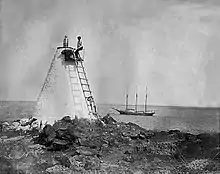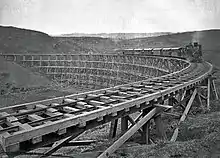Mahukona
Māhukona is a former settlement on the island of Hawaiʻi. The extinct submerged volcano Māhukona, off shore and to the south, is named for this area. The settlement was once the terminus of the Hawaiian Railroad.
 Original Māhukona light, 1904 | |
| Location | Mahukona, Hawaii, US |
|---|---|
| Coordinates | 20°10′49″N 155°54′05″W |
| Tower | |
| Constructed | 1899 |
| Construction | stone (tower) |
| Shape | truncated cone |
| Light | |
| Deactivated | 1915 |
| Focal height | 75 ft (23 m) |
| Range | 10 nmi (19 km; 12 mi) |
| Current light | |
| Constructed | 1915 |
| Construction | reinforced concrete |
| Height | 22 m (72 ft) |
| Shape | square pyramid |
| Markings | white (tower) |
| Operator | United States Coast Guard |
| Focal height | 64 m (210 ft) |
| Range | 6 nmi (11 km; 6.9 mi) |
| Characteristic | Fl W 4s |
History
Māhukona was a traditional ahupuaʻa (land division) that extended from a bay to the slopes of Kohala mountain. Much was owned by Princess Ruth Keʻelikōlani at one time. The name means "leeward steam" in the Hawaiian language.[1] Lapakahi State Historical Park is just to the south.[2] The harbor is located just off of Akoni Pule Highway, Hawaii Route 270.[3]
While Samuel Gardner Wilder was minister of the interior, he secured a charter for a railroad company in 1880. The first sugarcane plantation in the Kohala district was started by Elias Bond in 1863, but transportation proved difficult. Wilder's idea was to transport sugarcane from plantations on the wet windward side of Kohala to Māhukona where ships could land. Wilder already ran a steamship company, so built a pier at the Māhukona harbor. Samuel Parker planned a railroad from the east coast to the port of Hilo, but was unable to fund the project.[4] Work was begun in 1881, the first track opened in 1882, and by 1883 had reached about 20 miles (32 km) to the plantation at Niuliʻi, 20°13′23″N 155°44′48″W.[5] There it met the barrier of Pololū Valley.

Wilder named the first locomotive Kina'u, after his wife.[6] He had plans to extend his railroad to Hilo, but that did not happen until after his death, built by the Hawaii Consolidated Railway. The two never became connected as dreamed by Wilder. In 1897 the railroad reincorporated as the Hawaii Railway Company, Ltd., and was bought by the sugar companies in 1899.[4]
A sugar mill was built on the north side of the bay, and its remains still stand. A larger wharf was built in 1911 by the Territory of Hawaii that was immediately destroyed by a storm, and rebuilt. In 1913 it was the fourth busiest port in the islands, but only had 13 vessels enter.[7] The first lighthouse was built in 1889 just to the south of the bay.[8][9] In 1915 it was replaced by a concrete pyramid 22 feet (6.7 m) tall.[10] By 1937, the Kohala Sugar Company had consolidated into the mill at Māhukona, and became Mahukona Terminals Ltd. In 1941 the port closed for World War II. On October 29, 1945, the railroad closed.[4]
The town, which once consisted of about 40 families, was abandoned in the 1950s.[11] In 1956 the harbor was closed. The bay is now the site of a park of Hawaii County. Although called Māhukona Beach Park, the shoreline is rocky and lacks a sandy beach. Fishing, snorkeling, picnic areas, and camping are available.[12]
In the 1990s a developer obtained permits to build a golf course and resort in the area.[13] The land-holding company was renamed the Kohala Preserve Conservation Trust, LLC, but encountered opposition from area residents.[14] A historic song about Māhukona, translated as "sugar boiler"[15] was recently recorded.[16]
References
- Lloyd J. Soehren (2004). "lookup of Mahukona". on Hawaiian place names. Ulukau, the Hawaiian Electronic Library. Retrieved July 27, 2010.
- Lapakahi State Historical Park Archived 2010-10-17 at the Wayback Machine entry on Hawaiʻi State Park web site
- U.S. Geological Survey Geographic Names Information System: Māhukona
- Veronica S. Schweitzer (January 1998). "Sugar and Steam in Kohala". Coffee Times. Retrieved July 27, 2010.
- Anne M. Prescott (1899). Makapala-by-the-sea: Hawaii. Hawaiian Gazette Company. p. 19.
- J. C. Condé (1971). Narrow gauge in a kingdom: the Hawaiian Railroad Company, 1878-1897. Glenwood Publishers. ISBN 9780911760101.
- Chamber of Commerce of Honolulu (1914). Annual report. pp. 30, 48.
- Rowlett, Russ. "Lighthouses of the United States: Hawaii". The Lighthouse Directory. University of North Carolina at Chapel Hill. Retrieved November 6, 2016.
- Light List, Hawaii District 14 United States Coast Guard. Retrieved 6 November 2016
- United States Department of Commerce (1918). Report of the Secretary of Commerce and reports of bureaus. Government Printing Office. pp. 595, 598.
- "A grand Mahalo to our Māhukona 'Ohana". Kohala Preserve Conservation Trust web site. October 27, 2009. Archived from the original on February 21, 2010. Retrieved July 27, 2010.
- "North Kohala map". Shoreline access. on official Hawaiʻi County web site. Archived from the original on July 8, 2011. Retrieved July 27, 2010.
- "Surety Holdings Corp—10SB12G". US Securities and Exchange Commission. February 9, 2001. Retrieved July 27, 2010.
- David Kimo Frankel (July 2009). "Māhukona development challenged". Ka Wai Ola Loa. Vol. 2, no. 7. Archived from the original on June 15, 2011. Retrieved July 27, 2010.
- Kīhei de Silva (1997). "Māhukona". He Aloha Moku o Keawe: A Collection of Songs for Hawai‘i. Kamehameha Schools. Retrieved July 27, 2010. credited to book by Edward Kamakau Likalani (1852–1917).
- "Hoʻokena 5". album listing on Hoʻokena web site. 1999. Retrieved July 27, 2010. includes audio clip of song, track 14
External links
- Thomas A. Edison, Inc. (1906). "S.S. Kinau landing passengers, Mahukona, Hawaii". US Library of Congress. Retrieved July 26, 2010.
- "Minor light of Hawai'i - Mahukona, HI". Lighthouse friends web site. Retrieved July 26, 2010.
